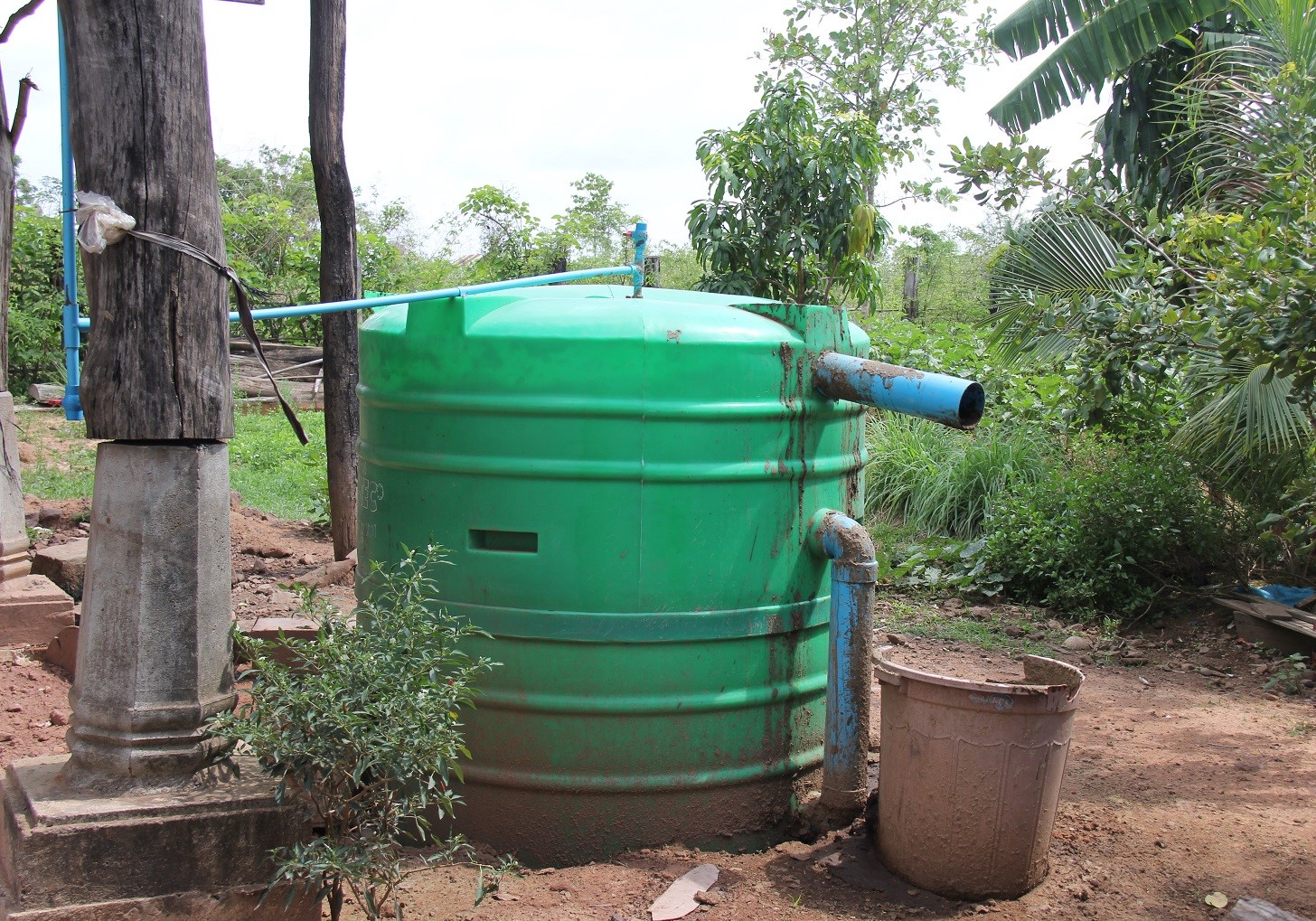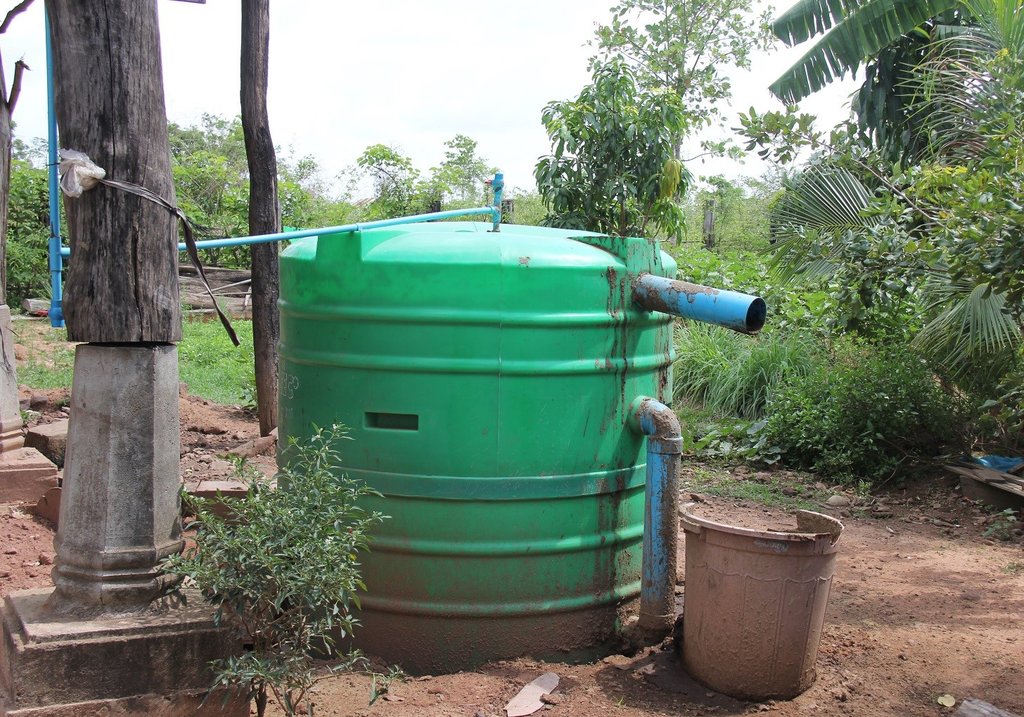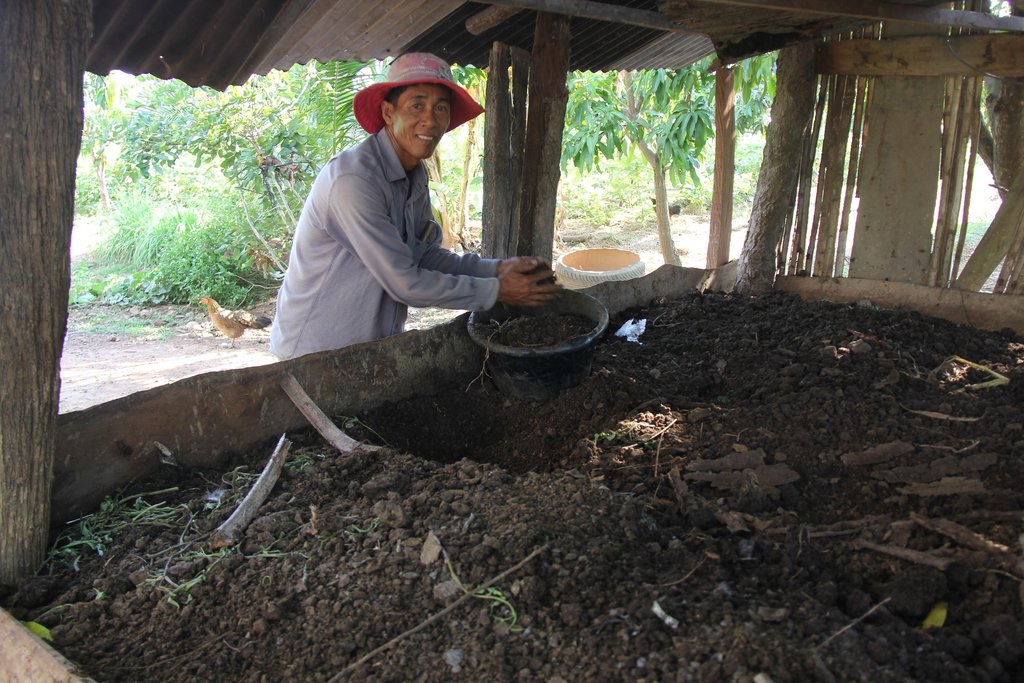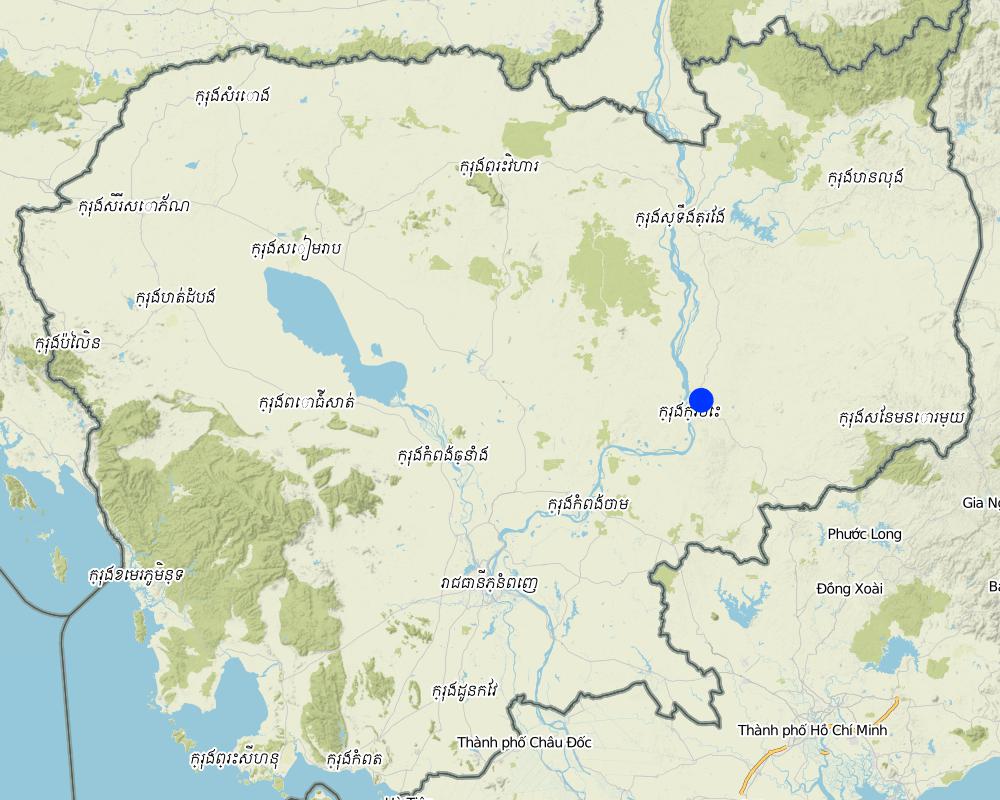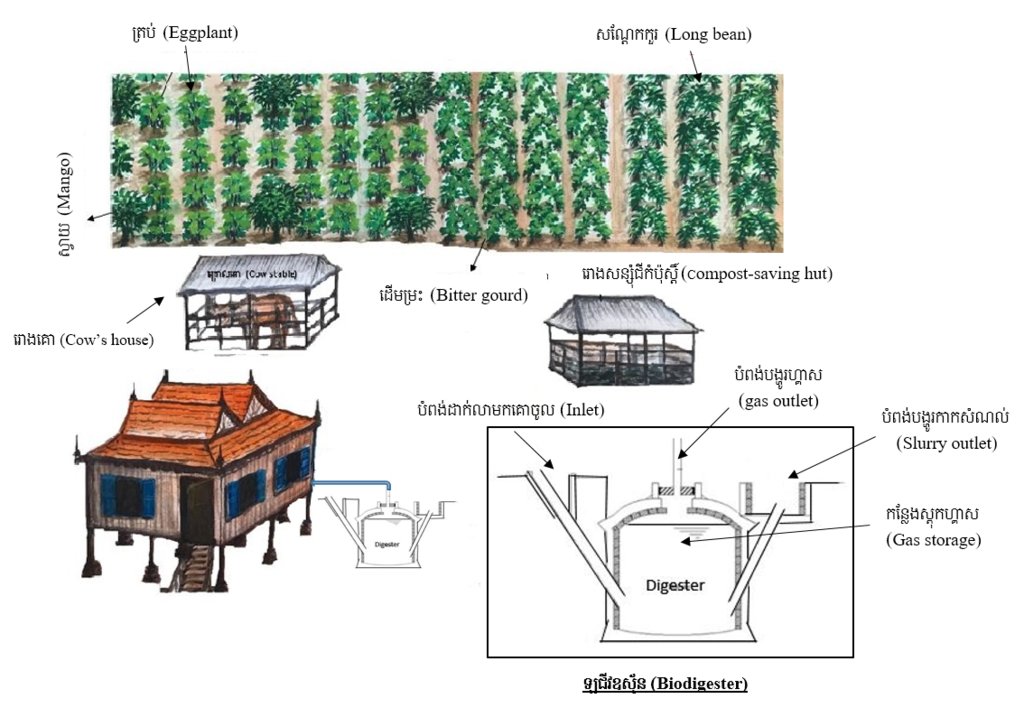ការប្រើប្រាស់កាកសំណល់ឡជីវឧស្ម័នសម្រាប់កែប្រែគុណភាពដី [Cambodia]
- Creation:
- Update:
- Compiler: Nary Lay
- Editors: Sophea Tim, SOBEN KIM, Navin Chea
- Reviewers: SO Than, Ursula Gaemperli, Alexandra Gavilano
ឡជីវឧស្ម័ន
technologies_2137 - Cambodia
View sections
Expand all Collapse all1. General information
1.2 Contact details of resource persons and institutions involved in the assessment and documentation of the Technology
ប្រធានទទួលបន្ទុករួមការិយាល័យកសិកម្ម រុក្ខាប្រមាញ់ និងនេសាទ ស្រុកព្រែកប្រសព្វ:
មន្ត្រីការិយាល័យកសិកម្ម រុក្ខាប្រមាញ់ និងនេសាទ ស្រុកចិត្របុរី:
សារ៉ាវុធ លី
ការិយាល័យកសិកម្មស្រុកចិត្របុរី
Cambodia
land user:
សុខ ស៊ុំ
កសិករ
Cambodia
ប្រធានការិយាល័យកសិកម្ម រុក្ខាប្រមាញ់ និងនេសាទ ស្រុកសំបូរ:
Name of project which facilitated the documentation/ evaluation of the Technology (if relevant)
Scaling-up SLM practices by smallholder farmers (IFAD)Name of the institution(s) which facilitated the documentation/ evaluation of the Technology (if relevant)
Royal University of Agriculture (RUA) - Cambodia1.3 Conditions regarding the use of data documented through WOCAT
The compiler and key resource person(s) accept the conditions regarding the use of data documented through WOCAT:
Ja
1.4 Declaration on sustainability of the described Technology
Is the Technology described here problematic with regard to land degradation, so that it cannot be declared a sustainable land management technology?
Nee
2. Description of the SLM Technology
2.1 Short description of the Technology
Definition of the Technology:
កាកសំណល់ពីឡជីវឧស្ម័នផលិតពីលាមកគោ ប្រើប្រាស់ធ្វើជាជីធម្មជាតិដ៏សំខាន់សម្រាប់ការងារដាំដុះ គឺជាប្រភេទ ជីសរីរាង្គពីធម្មជាតិដែលរលួយល្អ គ្មានក្លិនស្អុយ មិនមានគ្រាប់ស្មៅចង្រៃ ផ្សិត និងមេរោគផ្សេងៗ ហើយអាចប្រើ ប្រាស់បានភ្លាមៗក្រោយការបង្ហូរចេញ។ ជីប្រភេទនេះជួយបង្កើនគុណភាពដី រយៈពេលវែង ដោយសារវាជាជីសរីរាង្គ ដែលបម្លែងជាបណ្តើរៗជាសារធាតុចិញ្ចឹមសម្រាប់រុក្ខជាតិ។
2.2 Detailed description of the Technology
Description:
ឡជីវឧស្ម័នមានច្រើនប្រភេទ។ ឡដែលប្រើក្នុងបច្ចេកទេសនេះ គឺឡដែលមានរាងជាស៊ីឡាំង ផលិតពីប្លាស្ទិកមាន ចំណុះ ៥០០០ លីត្រ គេតម្លើងវាដោយជីកកប់តួធុងរបស់វាមួយចំណែកទៅក្នុងដី រួចរៀបចំប្រព័ន្ធបង្ហូរចូល-បង្ហូរចេញ និងប្រព័ន្ធទុយោហ្គាស ការរៀបចំតម្លើងនេះគឺអាចចំណាយពេលរហូតដល់មួយថ្ងៃ។ ដើម្បីអាចមានហ្គាសប្រើប្រាស់បានជាលើកដំបូង ឡជីវឧស្ម័នត្រូវការលាមកគោស្រស់ប្រមាណ ១២០ ធុងស្ពេត្រូ (ប្រហែល ២០០០ គីឡូក្រាម) និងទឹក ចំនួន ១២០ ធុងស្ពេត្រូ (ប្រហែល ១២០០ លីត្រ) ទុករយៈពេលមួយសប្តាហ៍ទើបអាចផលិតជាហ្គាស និងមានកាកសំណល់អាចប្រើប្រាស់បាន។ ជាបន្តបន្ទាប់ រៀងរាល់ថ្ងៃកសិករត្រូវបន្ថែមលាមកគោស្រស់ចំនួន ១ ធុងស្ពេត្រូ (២០ គីឡូក្រាម) និងទឹកចំនួន ១ ធុងស្ពេត្រូ (២០ លីត្រ) ដើម្បីមានហ្គាសប្រើប្រាស់ជាអចិន្ត្រៃយ៍។ ចំពោះគ្រួសារកសិករនេះ ហ្គាសដែលទទួលបានពីឡគឺ អាចផ្តល់នូវថាមពលគ្រប់គ្រាន់សម្រាប់ការចំអិនអាហារ ធ្វើឱ្យគាត់ចំណេញពេលវេលារកអុស និងសំចៃអុសប្រមាណជា ២១៩០ គីឡូក្រាមក្នុង ១ ឆ្នាំៗ។ លាមកគោដែលយកមកដាក់ឡជីវឧស្ម័នគឺជាលាមកស្រស់ និងមិនគួរឱ្យមានសំរាម ឬគ្រួសលាយឡំច្រើនពេកទេ ព្រោះវានឹងអាចធ្វើឱ្យស្ទះទាំងបំពង់ដាក់លាមកចូល និងបំពង់បង្ហូរកាកសំណល់ចេញ។
ក្រៅពីគោលបំណងសំខាន់នៃការប្រើប្រាស់ហ្គាសពីឡជីវឧស្ម័នសម្រាប់ចំអិនអាហារ និងសម្រាប់ការបំភ្លឺ កសិករ ក៏មានគោលបំណងប្រើប្រាស់កាកសំណល់ដែលចេញពីឡធ្វើជាជីសម្រាប់ដំណាំគ្រប់ប្រភេទដែរ គាត់បានប្រើលើដំណាំជាអាទិ៍មាន ម្រះ ត្រប់វែង ស្វាយ សណ្តែកគួរ ស្រូវ ឫស្សី (ទំពាំង) និងដំណាំរួមផ្សំផ្សេងៗទៀត។ កាកសំណល់ដែលចេញពីឡជីវឧស្ម័នមានទម្រង់ រាវ ពាក់កណ្តាលស្ងួត និង ស្ងួត។ កាកសំណល់ដែលចេញពីឡជីវឧស្ម័នអាចត្រូវបានយកទៅដាក់ដំណាំដោយផ្ទាល់ ឬយកទៅផលិតជាជីកំប៉ុស្តិ៍ដោយលាយជាមួយទន្ទ្រានខេត្ត ចំបើង និងស្លឹករុក្ខជាតិបៃតងផ្សេងទៀត ការធ្វើដូចនេះគឺដើម្បីបង្កើនបរិមាណជីព្រោះកាកសំណល់ពីឡជួយធ្វើឱ្យដំណើរការពុកផុយទៅជាជីកំប៉ុស្តិ៍បានលឿន ហើយជីកំប៉ុស្តិ៍មានគុណភាពខ្ពស់ទៀតផង។
កាកសំណល់ដែលទទួលបានពីឡនេះជួយឱ្យដីធូរ និងមានជីជាតិល្អក្នុងរយៈពេលវែងជាងការប្រើប្រាស់ជីគីមី។ កាកសំណល់ដែលបានមកពីឡនេះមានសារធាតុ ចិញ្ចឹមច្រើនជាពិសេស អាសូត ផូស្វ័រ និងប៉ូតាស្យូមដែលជាតម្រូវការចាំបាច់របស់រុក្ខជាតិ វាមិនមានក្លិនស្អុយ គ្មានគ្រាប់ស្មៅ និងពពួកបរាសិត សារធាតុចិញ្ចឹមត្រូវ បានបំលែងជាទម្រង់មួយដែលរុក្ខជាតិស្រូបយកយ៉ាងងាយ និងមានវីតាមីនបេ ១២ ដែលជម្រុញឱ្យជន្លេនឆាប់លូតលាស់ល្អ។ ការប្រើប្រាស់កាកសំណល់នេះ ធ្វើឱ្យដីធូរសម្បូរទៅដោយមីក្រូសរីរាង្គ និងសត្វមានប្រយោជន៍ដូចជា ជន្លេន កង្កែប និងសត្វល្អិតក្នុងដី ច្រើនប្រភេទទៀតក្នុងការរក្សាលំនឹងធម្មជាតិ។ ជីកាកសំណល់ធ្វើឱ្យដំណាំលូតលាស់បានល្អ ធន់ទ្រាំនឹងជម្ងឺ ដូច្នេះកសិករចំណេញថវិកាពីការទិញជីគីមី និងថ្នាំកំចាត់សត្វល្អិត ហើយមិនប៉ះពាល់ដល់ដី និងសុខភាពមនុស្សទៀតផង។ ចំពោះដីខ្សោះជីជាតិ ជីកាកសំណល់ឡជីវឧស្ម័នបានជួយកែលម្អដីឱ្យប្រសើរខ្លាំងទាំងលក្ខណៈរូបសាស្ត្រ និងជីវសាស្ត្រ ធ្វើឱ្យដីកាន់តែសម្បូរជីជាតិដែលមានទាំងពពួកម៉ាក្រូធាតុ និងមីក្រូធាតុ ធ្វើឱ្យដីមានសំណើម រក្សាទម្រង់ដីល្អ។
2.3 Photos of the Technology
2.5 Country/ region/ locations where the Technology has been applied and which are covered by this assessment
Country:
Cambodia
Region/ State/ Province:
ភូមិកំបោរ ឃុំគោលាប់ ស្រុកចិត្របុរី ខេត្តក្រចេះ។
Further specification of location:
ជនបទ
Specify the spread of the Technology:
- applied at specific points/ concentrated on a small area
Comments:
គម្រោងស៊ីបូដាបានដាក់ឡជីវឧស្ម័នប្រភេទនេះចំនួន ៦ គ្រួសារនៅក្នុងភូមិកំបោរ។
Map
×2.6 Date of implementation
Indicate year of implementation:
2016
2.7 Introduction of the Technology
Specify how the Technology was introduced:
- through projects/ external interventions
Comments (type of project, etc.):
គម្រោងកម្មវិធីឡជីវឧស្ម័នជាតិ
3. Classification of the SLM Technology
3.1 Main purpose(s) of the Technology
- improve production
- reduce, prevent, restore land degradation
- conserve ecosystem
- preserve/ improve biodiversity
- mitigate climate change and its impacts
- create beneficial economic impact
3.2 Current land use type(s) where the Technology is applied
Land use mixed within the same land unit:
Ja
Specify mixed land use (crops/ grazing/ trees):
- Agroforestry

Cropland
- Annual cropping
- Perennial (non-woody) cropping
- Tree and shrub cropping
Annual cropping - Specify crops:
- vegetables - melon, pumpkin, squash or gourd
- vegetables - other
- legumes and pulses - beans
- អង្ករនិង aubergine ។
Annual cropping system:
Vegetables - wheat/barley/oat/upland rice
Perennial (non-woody) cropping - Specify crops:
- banana/plantain/abaca
- sugar cane
Tree and shrub cropping - Specify crops:
- mango, mangosteen, guava
Number of growing seasons per year:
- 3
Specify:
ដាំបន្លែបន្តគ្នាពេញមួយឆ្នាំ
Comments:
ដំណាំចម្បង (ដំណាំកសិ-ឧស្សាហកម្ម និងដំណាំស្បៀង) : ស្រូវ អំពៅ ចេក ត្រប់វែង ម្រះ សណ្តែកកួរ ស្វាយ ទំពាំង និងបន្លែផ្សេងៗ
ចិញ្ចឹមគោ 19 ក្បាល សម្រាប់ផ្គត់ផ្គង់លាមកដាក់ចូលឡជីវឧស្ម័ន និងមាន់ 100 ក្បាល។
3.3 Has land use changed due to the implementation of the Technology?
Has land use changed due to the implementation of the Technology?
- Yes (Please fill out the questions below with regard to the land use before implementation of the Technology)

Forest/ woodlands
Comments:
ដីនេះពីមុនជាដីព្រៃរេចរឹល។
3.4 Water supply
Water supply for the land on which the Technology is applied:
- mixed rainfed-irrigated
Comments:
គាត់ប្រើទឹកអណ្តូងសម្រាប់ស្រោចស្រពដំណាំ
3.5 SLM group to which the Technology belongs
- integrated crop-livestock management
- energy efficiency technologies
3.6 SLM measures comprising the Technology

management measures
- M6: Waste management (recycling, re-use or reduce)
3.7 Main types of land degradation addressed by the Technology

physical soil deterioration
- Pu: loss of bio-productive function due to other activities

biological degradation
- Bs: quality and species composition/ diversity decline
- Bl: loss of soil life
3.8 Prevention, reduction, or restoration of land degradation
Specify the goal of the Technology with regard to land degradation:
- prevent land degradation
- reduce land degradation
4. Technical specifications, implementation activities, inputs, and costs
4.1 Technical drawing of the Technology
Technical specifications (related to technical drawing):
ឡផលិតពីប្លាស្ទិចមានចំណុះ ៥០០០ លីត្រ។ ឡជីវឧស្ម័នមានបំពង់ចំនួនបីគឺ បំពង់ដាក់លាមកគោចូល បំពង់បង្ហូរហ្គាស និងបំពង់បង្ហូរកាកសំណល់ចេញ។ ការដាក់លាមកគោនៅដំណាក់កាលដំបូងគឺ លាមកគោ ១២០ធុងស្ពេត្រូ (២០០០ គីឡូក្រាម) និងទឹក ១២០០ លីត្រ និងទុករយៈពេលមួយសប្តាហ៍បានហ្គាសប្រើប្រាស់នៅក្នុងផ្ទះ។ ត្រូវថែមលាមកគោ ១ ធុងស្ពេត្រូ ជាមួយទឹក ២០ លីត្រជារៀងរាល់ថ្ងៃ។ ឡជីវឧស្ម័នត្រូវបានជីកកប់តួធុងមួយចំណែកទៅក្នុងដី។ រោងជីកំប៉ុស្តិ៍មានទំហំ ៣×៣ ម៉ែត្រ កម្ពស់ ១.៦ ម៉ែត្រ ប្រក់សង្ក័សី ជញ្ជាំងកម្ពស់ ០.៥ ម៉ែត្រ ហើយដំបូលប្រក់សង្ក័សីការពារកម្តៅថ្ងៃ និងទឹកភ្លៀង។ ជីពីឡជីវឧស្ម័នត្រូវបានប្រើប្រាស់លើដំណាំជាច្រើនប្រភេទ។ ឡជីវឧស្ម័ននេះអាចផលិតហ្គាសបានប្រហែល ៤ម៉ែត្រត្រីគុណ និងអាចជំនួសឱ្យការប្រើអុសបានប្រហែល ២១៩០គីឡូក្រាម ក្នុងមួយឆ្នាំ។
Author:
លោក ឃួន សុផល
Date:
10/04/2017
4.2 General information regarding the calculation of inputs and costs
Specify how costs and inputs were calculated:
- per Technology unit
Specify unit:
ឡជីវឧស្ម័ន
other/ national currency (specify):
រៀល
If relevant, indicate exchange rate from USD to local currency (e.g. 1 USD = 79.9 Brazilian Real): 1 USD =:
4000.0
Indicate average wage cost of hired labour per day:
25000៛
4.3 Establishment activities
| Activity | Timing (season) | |
|---|---|---|
| 1. | ជីកដី | ខែឧសភា |
| 2. | ដាក់ធុងឡជីវឧស្ម័ន | ខែឧសភា |
| 3. | រៀបចំប្រព័ន្ធទុយោ | ខែឧសភា |
| 4. | តម្លើងចង្រ្កាន | ខែឧសភា |
| 5. | ដាក់លាមកគោ | ខែឧសភា |
4.4 Costs and inputs needed for establishment
| Specify input | Unit | Quantity | Costs per Unit | Total costs per input | % of costs borne by land users | |
|---|---|---|---|---|---|---|
| Equipment | ឡជីវឧស្ម័ន | ឈុត | 1.0 | 4000000.0 | 4000000.0 | 20.0 |
| Total costs for establishment of the Technology | 4000000.0 | |||||
| Total costs for establishment of the Technology in USD | 1000.0 | |||||
If you are unable to break down the costs in the table above, give an estimation of the total costs of establishing the Technology:
4000000.0
If land user bore less than 100% of costs, indicate who covered the remaining costs:
អង្គការជួយឧត្ថម្ភ
Comments:
អង្គការជួយឧត្ថម្ភចំនួន ៨០%នៃឡជីវឧស្ម័ន និងម្ចាស់ផ្ទះជួយវិភាគទាន ២០%។
4.5 Maintenance/ recurrent activities
| Activity | Timing/ frequency | |
|---|---|---|
| 1. | ការសម្អាតរន្ធបង្ហូរ | រាល់ថ្ងៃ |
| 2. | ការដាក់លាមកគោ | រាល់ថ្ងៃ |
4.6 Costs and inputs needed for maintenance/ recurrent activities (per year)
| Specify input | Unit | Quantity | Costs per Unit | Total costs per input | % of costs borne by land users | |
|---|---|---|---|---|---|---|
| Labour | ការសម្អាតធ្វើដោយខ្លួនឯង | ម៉ោង | 30.42 | 3124.0 | 95032.08 | 100.0 |
| Fertilizers and biocides | លាមកគោ | គីឡូក្រាម | 20.0 | 1200.0 | 24000.0 | 100.0 |
| Fertilizers and biocides | ទឹក | លីត្រ | 20.0 | 200.0 | 4000.0 | 100.0 |
| Total costs for maintenance of the Technology | 123032.08 | |||||
| Total costs for maintenance of the Technology in USD | 30.76 | |||||
4.7 Most important factors affecting the costs
Describe the most determinate factors affecting the costs:
មិនមានប៉ះពាល់ទេដោយសារវាមានសារៈសំខាន់ដោយអាចប្រើជាហ្គាស ជាជី ហើយលាមកគោអាចប្រើប្រាស់គ្រប់គ្រាន់ព្រោះមានគោច្រើន
5. Natural and human environment
5.1 Climate
Annual rainfall
- < 250 mm
- 251-500 mm
- 501-750 mm
- 751-1,000 mm
- 1,001-1,500 mm
- 1,501-2,000 mm
- 2,001-3,000 mm
- 3,001-4,000 mm
- > 4,000 mm
Specify average annual rainfall (if known), in mm:
1138.20
Indicate the name of the reference meteorological station considered:
នាយកដ្ឋានឧត្តុនិយមនៃក្រសួងធនធានទឹកនិងឧត្តុនិយម ២០១៥
Agro-climatic zone
- sub-humid
5.2 Topography
Slopes on average:
- flat (0-2%)
- gentle (3-5%)
- moderate (6-10%)
- rolling (11-15%)
- hilly (16-30%)
- steep (31-60%)
- very steep (>60%)
Landforms:
- plateau/plains
- ridges
- mountain slopes
- hill slopes
- footslopes
- valley floors
Altitudinal zone:
- 0-100 m a.s.l.
- 101-500 m a.s.l.
- 501-1,000 m a.s.l.
- 1,001-1,500 m a.s.l.
- 1,501-2,000 m a.s.l.
- 2,001-2,500 m a.s.l.
- 2,501-3,000 m a.s.l.
- 3,001-4,000 m a.s.l.
- > 4,000 m a.s.l.
Indicate if the Technology is specifically applied in:
- not relevant
5.3 Soils
Soil depth on average:
- very shallow (0-20 cm)
- shallow (21-50 cm)
- moderately deep (51-80 cm)
- deep (81-120 cm)
- very deep (> 120 cm)
Soil texture (topsoil):
- medium (loamy, silty)
Soil texture (> 20 cm below surface):
- fine/ heavy (clay)
Topsoil organic matter:
- low (<1%)
If available, attach full soil description or specify the available information, e.g. soil type, soil PH/ acidity, Cation Exchange Capacity, nitrogen, salinity etc.
pH: 5.5
5.4 Water availability and quality
Ground water table:
5-50 m
Availability of surface water:
good
Water quality (untreated):
good drinking water
Is water salinity a problem?
Nee
Is flooding of the area occurring?
Nee
Comments and further specifications on water quality and quantity:
គាត់ប្រើប្រាស់ទឹកអណ្តូងសម្រាប់ស្រោចស្រព និងប្រើប្រាស់បានពេញមួយឆ្នាំ។
5.5 Biodiversity
Species diversity:
- low
Habitat diversity:
- low
5.6 Characteristics of land users applying the Technology
Sedentary or nomadic:
- Sedentary
Market orientation of production system:
- commercial/ market
Off-farm income:
- 10-50% of all income
Relative level of wealth:
- average
Individuals or groups:
- individual/ household
Level of mechanization:
- manual work
Gender:
- men
Age of land users:
- middle-aged
5.7 Average area of land used by land users applying the Technology
- < 0.5 ha
- 0.5-1 ha
- 1-2 ha
- 2-5 ha
- 5-15 ha
- 15-50 ha
- 50-100 ha
- 100-500 ha
- 500-1,000 ha
- 1,000-10,000 ha
- > 10,000 ha
Is this considered small-, medium- or large-scale (referring to local context)?
- medium-scale
Comments:
គាត់មានដីស្រែ ៣ហិចតា និងដីដាំដំណាំ ១៥អា និងដីទុកចោល ១ហិចតា (នៅព្រៃ)។
5.8 Land ownership, land use rights, and water use rights
Land ownership:
- individual, titled
Land use rights:
- individual
Water use rights:
- individual
5.9 Access to services and infrastructure
health:
- poor
- moderate
- good
education:
- poor
- moderate
- good
technical assistance:
- poor
- moderate
- good
employment (e.g. off-farm):
- poor
- moderate
- good
markets:
- poor
- moderate
- good
energy:
- poor
- moderate
- good
roads and transport:
- poor
- moderate
- good
drinking water and sanitation:
- poor
- moderate
- good
financial services:
- poor
- moderate
- good
6. Impacts and concluding statements
6.1 On-site impacts the Technology has shown
Socio-economic impacts
Production
crop production
Quantity before SLM:
១៥០ គ.ក្រក្នុង១ខែ
Quantity after SLM:
៤៥០ គ.ក្រក្នុង១ខែ
crop quality
Comments/ specify:
ប្រើជីកំប៉ុស្តិ៍ផលិតពីកាកសំណល់ឡជីវឧស្ម័នជាជីមានជីជាតិខ្ពស់ ហើយផលដំណាំមិនមានផ្ទុកជាតិគីមី។
animal production
Quantity before SLM:
១០ ក្បាល
Quantity after SLM:
១៩ ក្បាល
Comments/ specify:
ដោយសារត្រូវការយកលាមកគោដាក់ក្នុងឡជីវឧស្ម័នដើម្បីផលិតហ្គាស
risk of production failure
Comments/ specify:
បន្ទាប់ពីប្រើជីកាកសំណល់ពីឡគាត់អាចដាំដំណាំច្រើនមុខ ហើយការមិនបានផលដំណាំណាមួយគាត់នៅតែទទួលផលពីដំណាំផ្សេងទៀត។
product diversity
Comments/ specify:
ដោយសារតែជីសំណល់ឡល្អសម្រាប់គ្រប់ដំណាំ កសិករអាចដាំដំណាំច្រើនប្រភេទចម្រុះគ្នា។
land management
Comments/ specify:
ដោយសារជីផលិតបានដោយខ្លួនឯង កសិករកាន់តែមានភាពងាយស្រួលក្នុងការគ្រប់គ្រងដីនិងបានល្អជាងមុន។
energy generation
Comments/ specify:
បញ្ឈប់ការទៅរកកាប់អុស ដោយបែរមកប្រើហ្គាសចេញពីឡជីវឧស្ម័នសម្រាប់ចំអិនអាហារ ដែលជំនួសការប្រើអុសប្រមាណ ២១៩០គីឡូក្រាមក្នុងមួយឆ្នាំ (គាត់ប្រើអុស ៦គីឡូក្រាមក្នុង១ថ្ងៃ)។
Income and costs
expenses on agricultural inputs
Comments/ specify:
ពុំត្រូវការទិញជីគីមី
farm income
Quantity before SLM:
15 %
Quantity after SLM:
45 %
Comments/ specify:
កសិករទទួលបានផលិតផលច្រើនពីដំណាំចម្រុះគ្នាបន្ទាប់ពីមានជីល្អប្រើប្រាស់។
workload
Comments/ specify:
មិនពិបាកទៅរកអុស
Socio-cultural impacts
food security/ self-sufficiency
Comments/ specify:
គាត់មានផលដំណាំសម្រាប់ហូបពេញមួយឆ្នាំ និងមានសល់សម្រាប់លក់បានទៀត។
health situation
Comments/ specify:
មិនសូវឈឺដូចពីមុន ប្រហែលដោយសារហូបអាហារផលិតខ្លួនឯងដែលមិនមានជាតិគីមី និងគាត់មិនប៉ះពាល់ជាមួយថ្នាំគីមីតាមរយៈការបាញ់ថ្មាំដូចពីមុន។
SLM/ land degradation knowledge
Comments/ specify:
បានចូលរួមវគ្គបណ្តុះបណ្តាលពីការផលិតជីកំប៉ុស្តិ៍ និងការដាំបន្លែ និងទស្សនៈកិច្ចនៅទីវាល។
Ecological impacts
Water cycle/ runoff
evaporation
Comments/ specify:
គាត់ដាំដំណាំច្រើនគ្របលើដីពេញមួយឆ្នាំ ហើយដំណាំខ្ពស់ៗដូចជាស្វាយក៏ជួយផ្តល់ម្លប់ដល់ដីដែលបន្ថយការរំហួត។
Soil
soil moisture
Comments/ specify:
ដោយសារបង្កើនសារធាតុសរីរាង្គច្រើនពីជីកំប៉ុស្តនៅស្រទាប់លើ និងមានដំណាំគម្រប។
soil cover
Comments/ specify:
ដោយសារមានដំណាំច្រើនគ្រប់រដូវ។
soil organic matter/ below ground C
Comments/ specify:
ដីមានជីជាតិល្អដោយសារឧស្សាហ៍ដាក់ជីកំប៉ុស្ត។
Biodiversity: vegetation, animals
plant diversity
Comments/ specify:
ដោយសារដីមានជីជាតិធ្វើឱ្យរុក្ខជាតិដុះច្រើន។
animal diversity
Comments/ specify:
មានការកើនឡើងនូវកូនកង្កែប មានដុកដឿ ជន្លេន
beneficial species
Comments/ specify:
មានកូនកង្កែប កង្កូវដួង និងជន្លេន
pest/ disease control
Comments/ specify:
នូវមានសត្វល្អិតបំផ្លាញខ្លះ តែបើប្រៀបធៀបនឹងពីមុនមានការថយចុះច្រើនព្រោះដីពុំសូវមានមេរោងដែលកើតចេញពីការប្រើជីគីមី។
6.2 Off-site impacts the Technology has shown
impact of greenhouse gases
Comments/ specify:
មិនមានការដុតអុសសម្រាប់ចំអិនអាហារ និងរួមទាំងការពារព្រៃឈើសម្រាប់ជាការស្រូបកាបូន។
6.3 Exposure and sensitivity of the Technology to gradual climate change and climate-related extremes/ disasters (as perceived by land users)
Gradual climate change
Gradual climate change
| Season | increase or decrease | How does the Technology cope with it? | |
|---|---|---|---|
| annual temperature | increase | moderately | |
| seasonal temperature | wet/ rainy season | increase | moderately |
| annual rainfall | increase | moderately | |
| seasonal rainfall | wet/ rainy season | increase | moderately |
Climate-related extremes (disasters)
Climatological disasters
| How does the Technology cope with it? | |
|---|---|
| drought | well |
Biological disasters
| How does the Technology cope with it? | |
|---|---|
| epidemic diseases | moderately |
| insect/ worm infestation | moderately |
Comments:
ពេលក្តៅខ្លាំងវាអាចជួយរក្សាសំណើមនៅលើដីផងដែរកុំឱ្យឆាប់ស្ងួត។
6.4 Cost-benefit analysis
How do the benefits compare with the establishment costs (from land users’ perspective)?
Short-term returns:
very positive
Long-term returns:
very positive
How do the benefits compare with the maintenance/ recurrent costs (from land users' perspective)?
Short-term returns:
very positive
Long-term returns:
very positive
Comments:
មិនទាន់មានការចំណាយទៅលើការជួសជុលទេ។
6.5 Adoption of the Technology
- 1-10%
If available, quantify (no. of households and/ or area covered):
មានចំនួន ៦ គ្រួសារដែលគម្រោងឱ្យឡជីវឧស្ម័ន
Of all those who have adopted the Technology, how many did so spontaneously, i.e. without receiving any material incentives/ payments?
- 0-10%
Comments:
ចង់ធ្វើឡជីវឧស្ម័ននេះដែរតែត្រូវចំណាយច្រើនហើយគ្មានលុយធ្វើ។
6.6 Adaptation
Has the Technology been modified recently to adapt to changing conditions?
Nee
6.7 Strengths/ advantages/ opportunities of the Technology
| Strengths/ advantages/ opportunities in the land user’s view |
|---|
| ធ្វើជាជីស្រោចដំណាំ |
| អាចដាក់ក្នុងដំណាំផ្ទាល់មិនធ្វើឱ្យរលួយ តែបើយកលាមកគោស្រស់មកដាក់ផ្ទាល់ភ្លាមធ្វើឱ្យរលួយ និងដុះស្មៅច្រើន |
| ដោយកាត់បន្ថយការប្រើអុស ២១៩០ គីឡូក្រាមក្នុងមួយឆ្នាំ |
| Strengths/ advantages/ opportunities in the compiler’s or other key resource person’s view |
|---|
| ជួយឱ្យដីមានជីជាតិ |
| កាត់បន្ថយការប៉ះពាល់ដល់បរិស្ថាន |
| កាត់បន្ថយការចំណាយប្រចាំថ្ងៃ |
6.8 Weaknesses/ disadvantages/ risks of the Technology and ways of overcoming them
| Weaknesses/ disadvantages/ risks in the land user’s view | How can they be overcome? |
|---|---|
| ឡជីវឧស្ម័នមានតម្លៃថ្លៃ | បានគម្រោងកម្មវិធីឡជីវឧស្ម័នជាតិជួយធ្វើ |
| Weaknesses/ disadvantages/ risks in the compiler’s or other key resource person’s view | How can they be overcome? |
|---|---|
| ឡជីវឧស្ម័នមានតម្លៃថ្លៃ | ត្រូវការមានការបដិភាគពីស្ថាប័នពាក់ព័ន្ធ |
| ត្រូវការលាមកសត្វ | ជំរុញការចិញ្ចឹមសត្វជាពិសេសគោ |
7. References and links
7.1 Methods/ sources of information
- field visits, field surveys
១ នាក់
- interviews with land users
១ នាក់
- compilation from reports and other existing documentation
កម្មវិធីឡជីវឧស្ម័នជាតិ
When were the data compiled (in the field)?
10/04/2017
7.2 References to available publications
Title, author, year, ISBN:
National Biodigester Programme (2013): Farmers Handbook on Management and Use of waste biodigester. Public on January 10th (in khmer)
Available from where? Costs?
Ministry of Agriculture, Forestry and Fisheries
7.3 Links to relevant online information
Title/ description:
National Biodigester Program.(2015). National Biodigester Program in CAMBODIA.Ministry of Agriculture, Forestry and Fisheries (in Khmer).retrieve 15/01/2018 from
URL:
www.nbp.org.kh
Title/ description:
Savbory,O.(2014). Mistry announce farmer to use biodigester for get prot.Radio Free Asia (in Khmer). retrieved on 15/01/2018 from
URL:
www.rfa.org/khmer/news/environment/bio-mass-oven-03062014034222.html
Title/ description:
Mansvelt,R. et al. (2012).Biodigester User Survey 2012.National Biodigester Programme.retrieved 15/01/2018 from
URL:
https://www.google.com/search?q=Biogas+user+survey+-+Cambodia+2009-2010+&ie=utf-8&oe=utf-8&client=refox-b-ab
Title/ description:
Mansvelt,R.(2011).Biodigester User Survey 2009-2010. National Biodigester Programme.retrieved 15/01/2018 from
URL:
https://www.google.com/search? q=Biogas+user+survey+-+Cambodia+2009-2010+&ie=utf-8&oe=utf-8&client=refox-b-ab
Links and modules
Expand all Collapse allLinks
No links
Modules
No modules


